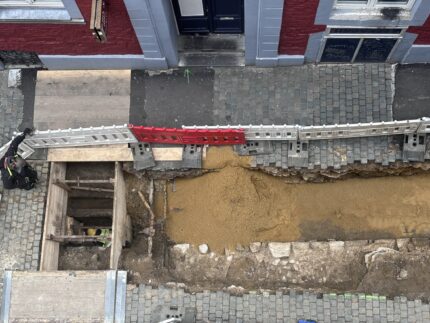 The remains of a 3rd century Roman fortification have been unearthed in Aachen, Germany. An excavation in concert with infrastructure work on the Pontstrasse uncovered the foundation of a large masonry wall of Roman construction. The excavation has so far revealed a 23-foot section of wall three feet thick. The full length and maximum width of the surviving segment have not yet been uncovered.
The remains of a 3rd century Roman fortification have been unearthed in Aachen, Germany. An excavation in concert with infrastructure work on the Pontstrasse uncovered the foundation of a large masonry wall of Roman construction. The excavation has so far revealed a 23-foot section of wall three feet thick. The full length and maximum width of the surviving segment have not yet been uncovered.
Fames as the capital of Charlemagne’s empire (800-814 A.D.) and the city where subsequent kings of Germany and Holy Roman Emperors were crowned until 1531, Aachen’s history long predates the Middle Ages. It was a Celtic settlement before the Roman legions occupied it in the early 1st century, developing its natural sulfur thermal springs into a bath complex and sanctuary. The Roman military presence ended in the 370s under pressure from migrating Germanic tribes. Frankish rule was established a hundred years later.
Scholars have believed since the 1880s that there was a late Roman fort in Aachen, but its location was unknown and it was only in 2011 and 2014 that excavations found remnants of the castrum at the bottom of the market hill.
After Aachen was destroyed in the course of Frankish raids around 275/276 AD, the entire market hill was reinforced with a wall with round towers that was five meters wide at the foundation. In front of it was a ditch around six meters wide. The latter was discovered on the Katschhof in 2011. Comparable forts are known from Jülich, Bitburg and Jünkerath. The late Roman defensive wall was continued to be used by Charlemagne. Its King’s Hall (today’s town hall) was built on its southern flank. The fort walls were not demolished until the 12th century.
Emperor Frederick Barbarossa demolished the ancient walls when he built new defensive walls between 1172 and 1176, but obviously he didn’t obliterate every trace of them. One notable section of wall with the base of one of the round towers has been preserved under a plexiglass floor in front of the restrooms of the Five Guys restaurant in the Markt 46 building.
The remains of the wall that have now been encountered run parallel to Pontstrasse. “It could be the remains of a gate,” suspect Schaub and Kyritz. The experts suspect further gates along Jakobsstrasse at the junction with the market and at the beginning of Großkölnstrasse. However, there are no concrete findings for this.
The aim is to preserve the remarkable current archaeological find as best as possible. Intensive discussions are currently underway on this. After the archaeological finds have been assessed and documented, construction work at the site will continue as planned. Basically, the excavation work in Pontstrasse is already continuing under archaeological supervision.
Aachen was granted city rights in 1166 by Barbarossa, and in Charlemagne’s Aachen Cathedral there is the 12th century Barbarossa Chandelier.
Indeed, the current inner city walls date to Barbarossa’s time. However, in the 13th century, after Emperor Frederick II was excommunicated by Pope Innocent IV, William II count of Holland and Zeeland was to be elected as German anti-king.
Before his coronation in 1248, unfortunately, William had to lay the city under siege for 6 months: He flooded Aachen with water, and pretty much the area that was back then *not* flooded is more or less identical with that “3rd century Roman fortification”.
In 1257, Richard of Cornwall was elected as King of Germany and crowned in Aachen on May 17th, and apparently he had been involved in the erection of the –still existing– first town hall at the Fish Market, the “Grashaus”.
The 2nd town hall was built in the 14th century on top of the foundation walls of the Aula Regia, the derelict Palace of Aachen. Altogether, there are three townhalls and now THREE defensive walls 🤠️